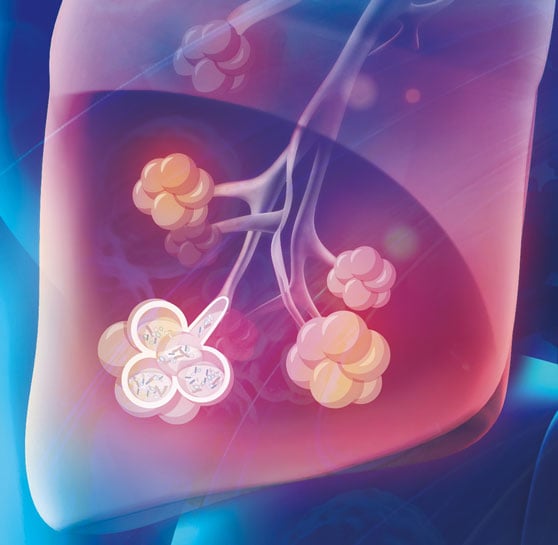Improve pulmonary infection diagnosis and management with DNA diagnostics from MicroGenDX
Culture-based antibiotics not working for your patients? Switch to molecular.

MicroGenDX DNA diagnostics are faster than culture, have higher sensitivity, are not affected by transport temperature or time, have a over 15-year CAP-verified accuracy of 99.2% — and your patients can take the test kit home to collect and submit a sputum sample directly to the MicroGenDX lab. If your patients have already received recent antibiotic treatment, then additional culture tests will not work. MicroGenDX qPCR+NGS results are not impacted by antibiotic use. Also included with every test are detection of 17 antimicrobial resistance genes and antimicrobials for consideration based on the Sanford and Johns Hopkins Guides.
For bronchiectasis, COPD, NTM infections, chronic bronchitis, cystic fibrosis, and HAP/VAP, MicroGenDX qPCR + Next-Gen DNA Sequencing (NGS) also identifies mycobacteria, anaerobes, and fungi that culture does not. MicroGenDX test results available in just 24 hours from sample receipt, and antimicrobial resistance genes in just 24 hours.
MicroGenDX tests also utilize an AMA-approved, Medicare-accepted PLA code that results in a much lower cost to insurance and patients than competing labs. And although take-home collection kits allow patients convenience in sputum collection, BAL and swab samples are also accepted.
Clinical research demonstrates that MicroGenDX qPCR+NGS offers a more comprehensive view of infective organism interrelationships and identifies mycobacteria and fungi more quickly (24 hours from sample receipt) than techniques relying on routine culture. Additional examples of qPCR+NGS advantages supported by research include:
- Rapid and reliable identification of mycobacteria, polymicrobial, and anaerobic organisms involved in aspiration pneumonia
- Facilitation of personalized diagnosis and therapy for patients with chronic lung diseases and/or infections that improves patient outcomes
- Molecular studies suggest that microbiota profiles of CF patients were patient-specific and remained stable over time. Read study
Better diagnosis and outcomes for pneumonia patients
- In an outcome comparison study, 28-day and 90-day mortality of NGS diagnostics groups were significantly lower than the control group for severe pneumonia. Access study
- In more than 60% of cases, despite radiographic evidence of pneumonia, bacterial or viral organisms cannot be identified using traditional methods. Read study
- Sputum culture and chest X-rays continue to be relied on, but the former lacks sensitivity and has an extended turnaround time, and the latter lacks specificity. Access study
- A 61-year-old male had been diagnosed with severe pneumonia and treated with empiric broad-spectrum antibacterial and antifungal drugs before bronchoscopy was performed. The patient responded poorly to those empiric treatments. Three fungi were found by NGS in the BALF: Pneumocystis jirovecii, Aspergillus fumigatus, and Rhizopus oryzae. Patient clinical improvement was achieved after adjusting to appropriate therapy based on NGS results. Read study
How MicroGenDX compares to the competition
| National Jewish Health | MicroGenDX | |
|---|---|---|
| Take-home testing kit | – | √ |
| NGS sequencing platform | Illumina MiSeq | Illumina MiSeq i100 Plus |
| NGS turnaround time | >15 days | 24 hours from sample receipt |
| Bacteria | √ | √ |
| Mycobacteria | √ | √ |
| Fungi | – | √ |
| Resistance genes | ||
| Macrolide | √ | √ |
| Aminoglycoside | √ | √ |
| Methicillin | – | √ |
| Vancomycin | – | √ |
| ESBL | – | √ |
| Carbapenemase | – | √ |
| Tetracycline | – | √ |
| Beta-Lactam | – | √ |
| Bactrim | – | √ |
| Fluoroquinolones | – | √ |
References
- Mahboubi MA, Carmody LA, Foster BK, et al. 2016. Culture-based and culture-independent bacteriologic analysis of cystic fibrosis respiratory specimens. J Clin Microbiol 54:613– 619. doi:10.1128/JCM.02299-15.
- Yun Z, Du J, Jin W, et al. Next generation sequencing for diagnosis of severe pneumonia: China, 2010-2018. J Infect. 2019 Feb;78(2):158-169. doi: 10.1016/j.jinf.2018.09.004
Jain S, Self WH, Wunderink RG, Fakhran S, et al; CDC EPIC Study Team. Community-Acquired Pneumonia Requiring Hospitalization among U.S. Adults. N Engl J Med. 2015 Jul 30;373(5):415-27. doi: 10.1056/NEJMoa1500245.
Albaum M, Hill L, et al. Interobserver reliability of the chest radiograph in community-acquired pneumonia. Chest. 1996;110:343-350.
Zhang K, Yu C, Li Y, Wang Y. Next-generation sequencing technology for detecting pulmonary fungal infection in bronchoalveolar lavage fluid of a patient with dermatomyositis: a case report and literature review. BMC Infect Dis. 2020 Aug 17. doi: 10.1186/s12879-020-05341-8

